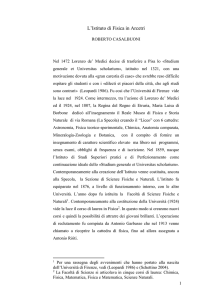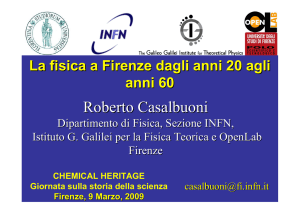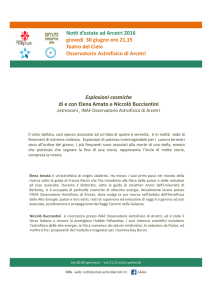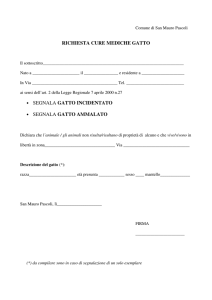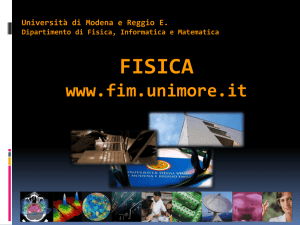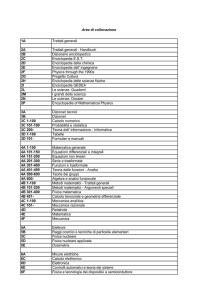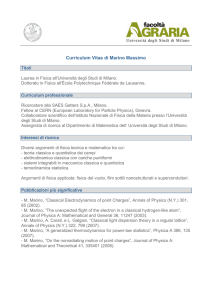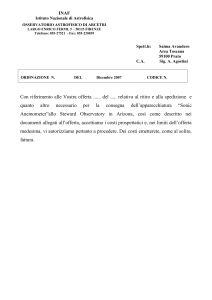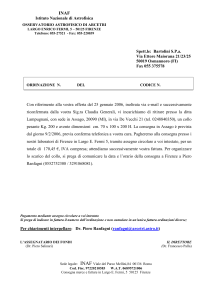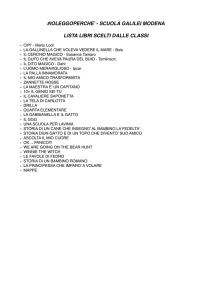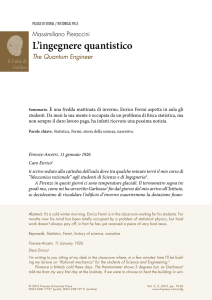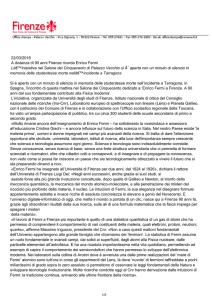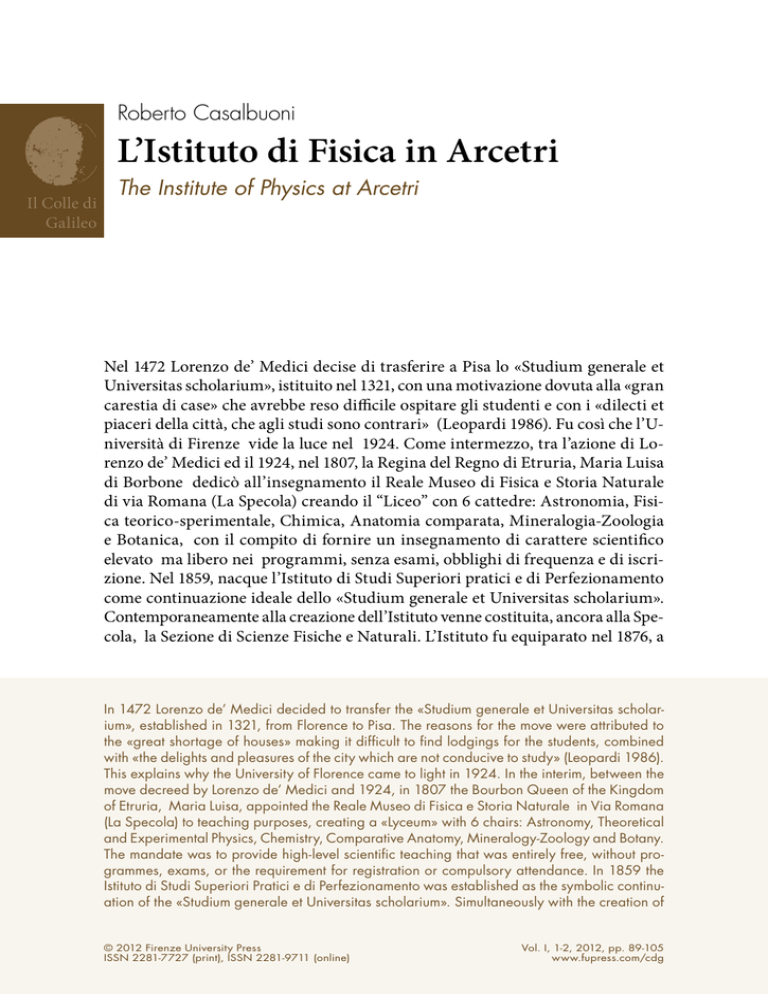
Roberto Casalbuoni
L’Istituto di Fisica in Arcetri
Il Colle di
Galileo
The Institute of Physics at Arcetri
Nel 1472 Lorenzo de’ Medici decise di trasferire a Pisa lo «Studium generale et
Universitas scholarium», istituito nel 1321, con una motivazione dovuta alla «gran
carestia di case» che avrebbe reso difficile ospitare gli studenti e con i «dilecti et
piaceri della città, che agli studi sono contrari» (Leopardi 1986). Fu così che l’Università di Firenze vide la luce nel 1924. Come intermezzo, tra l’azione di Lorenzo de’ Medici ed il 1924, nel 1807, la Regina del Regno di Etruria, Maria Luisa
di Borbone dedicò all’insegnamento il Reale Museo di Fisica e Storia Naturale
di via Romana (La Specola) creando il “Liceo” con 6 cattedre: Astronomia, Fisica teorico-sperimentale, Chimica, Anatomia comparata, Mineralogia-Zoologia
e Botanica, con il compito di fornire un insegnamento di carattere scientifico
elevato ma libero nei programmi, senza esami, obblighi di frequenza e di iscrizione. Nel 1859, nacque l’Istituto di Studi Superiori pratici e di Perfezionamento
come continuazione ideale dello «Studium generale et Universitas scholarium».
Contemporaneamente alla creazione dell’Istituto venne costituita, ancora alla Specola, la Sezione di Scienze Fisiche e Naturali. L’Istituto fu equiparato nel 1876, a
In 1472 Lorenzo de’ Medici decided to transfer the «Studium generale et Universitas scholarium», established in 1321, from Florence to Pisa. The reasons for the move were attributed to
the «great shortage of houses» making it difficult to find lodgings for the students, combined
with «the delights and pleasures of the city which are not conducive to study» (Leopardi 1986).
This explains why the University of Florence came to light in 1924. In the interim, between the
move decreed by Lorenzo de’ Medici and 1924, in 1807 the Bourbon Queen of the Kingdom
of Etruria, Maria Luisa, appointed the Reale Museo di Fisica e Storia Naturale in Via Romana
(La Specola) to teaching purposes, creating a «Lyceum» with 6 chairs: Astronomy, Theoretical
and Experimental Physics, Chemistry, Comparative Anatomy, Mineralogy-Zoology and Botany.
The mandate was to provide high-level scientific teaching that was entirely free, without programmes, exams, or the requirement for registration or compulsory attendance. In 1859 the
Istituto di Studi Superiori Pratici e di Perfezionamento was established as the symbolic continuation of the «Studium generale et Universitas scholarium». Simultaneously with the creation of
© 2012 Firenze University Press
ISSN 2281-7727 (print), ISSN 2281-9711 (online)
Vol. I, 1-2, 2012, pp. 89-105
www.fupress.com/cdg
90
Roberto Casalbuoni
livello di funzionamento interno, con le altre Università. L’anno dopo fu istituita
la Facoltà di Scienze Fisiche e Naturali1. Contemporaneamente alla costituzione
della Università (1924) vide la luce il corso di laurea in Fisica2. In questo modo si
crearono nuovi corsi e quindi la possibilità di attrarre dei giovani brillanti. L’operazione di reclutamento fu compiuta da Antonio Garbasso che nel 1913 venne
chiamato a ricoprire la cattedra di fisica, fino ad allora assegnata a Antonio Ròiti.
Antonio Garbasso è stato una figura fondamentale per la fisica fiorentina e
a buon diritto può esserne considerato il padre fondatore. Nacque a Vercelli nel
1871, si laureò in Fisica a Torino nel 1892 e studiò con fisici famosi quali Hertz a
Bonn e Helmoltz a Berlino. Diventò Professore di Matematica a Pisa nel 1895. Fu
poi a Torino e Genova sino al 1913, anno in cui si trasferì a Firenze. Fu un ottimo
fisico, si occupò di ottica (spiegando il fenomeno del miraggio) e di spettroscopia. In particolare dette la spiegazione teorica dell’effetto Stark (scoperto anche
da Lo Surdo a Firenze). Ma Garbasso fu anche una importante figura pubblica.
Nel campo della Fisica, facendo il Presidente della SIF per due periodi, 1912-1914
e 1921-1925 e Presidente del Comitato di Astronomia, Matematica e Fisica del
CNR. In campo politico fu Sindaco di Firenze, poi Podestà nel 1924-1928 ed infine
Senatore del Regno (1924). Fu delegato del Ministero dell’Educazione Nazionale
nel Comitato Tecnico per l’Industria Ottica ed ebbe un ruolo importante nel dibattito politico-culturale che accompagnò la riforma dell’istruzione di Giovanni
Gentile, opponendosi alla impostazione prettamente umanistica a danno delle
discipline scientifiche. Garbasso volle che Firenze fosse dotata di un moderno
Istituto di Fisica (inaugurato il 7 Novembre 1921, vedi Fig. 1) e riuscì a realizzarlo
the Institute, the Physical and Natural Sciences Section was set up, again at the Specola. In
1876 the internal functioning of the Institute was brought into line with the other universities.
In the following year the Faculty of Physical and Natural Sciences was established.1 The degree course in Physics2 came into being when the university was founded in 1924. This led to
the creation of new courses and hence the possibility of attracting brilliant young minds. The
recruitment operation was carried out by Antonio Garbasso, who in 1913 was invited to take
the chair of Physics which had previously been assigned to Antonio Ròiti.
Antonio Garbasso was a fundamental figure in Florentine physics and can rightly be considered its founding father. He was born in Vercelli in 1871, graduated in physics in Turin in
1892 and studied under famous physicists including Hertz in Bonn and Helmoltz in Berlin. He
became Professor of Mathematics in Pisa in 1895, after which he was in Turin and Genoa up
to 1913, when he moved to Florence. He was an outstanding physicist; he dealt with optics (explaining the phenomenon of the mirage) and with spectroscopy. More specifically he provided
the theoretical explanation of the Stark effect (which was also discovered by Lo Surdo in Florence). In addition to this, Garbasso was also an important public figure. In the field of Physics, he was twice President of the Italian Physical Society (SIF) during the periods 1912-1914
and 1921-1925 and Chairman of the Astronomy, Mathematics and Physics Committee of the
CNR (National Research Council). In the field of politics he was Mayor of Florence, and later
Podestà from 1924 to 1928 and finally Senator of the Kingdom (1924). He was a delegate
from the National Education Ministry on the Technical Committee for the Optics Industry and
Roberto Casalbuoni
L’Istituto di Fisica in Arcetri
ad Arcetri. Questa località fu scelta sia per motivi storici, la vicinanza alla Villa
‘Il Gioiello’3 che per motivi strategici, la vicinanza con l’Osservatorio (che come
vedremo fu di enorme importanza per lo sviluppo della Fisica).
L’opera di reclutamento ebbe inizio con Franco Rasetti nel 1921. In quegli anni Antonio Garbasso ebbe come assistenti Antonino Lo Surdo, Augusto Raffaele
Occhialini (padre di Beppo), Rita Brunetti, che andò in cattedra nel 1926 a Ferrara e poi fu la prima donna in Italia con la posizione di Direttore di Istituto a
Cagliari a partire dal 1928 e Vasco Ronchi che diventò dopo alcuni anni direttore dell’Istituto Nazionale di Ottica che sorse e si sviluppò accanto all’Istituto di
Fisica grazie proprio a Garbasso.
Nel 1925 Garbasso chiamò Enrico Fermi, che rimase sino al 1926 quando
vinse il concorso di Fisica Teorica a Roma. Tra Fermi e Rasetti si stabilì una
grande amicizia e collaborazione (vedi Fig. 2). Fermi insegnava a Rasetti la Fisica Teorica, mentre questi insegnava a sua volta a Fermi l’arte della sperimentazione di cui era un vero maestro. In quel periodo Fermi e Rasetti scrissero
vari articoli in collaborazione. Il periodo di Firenze è stato descritto in modo
molto colorito da Laura Fermi nel suo libro (Fermi 1954). Rasetti aveva molte
passioni ed in seguito divenne un esperto di geologia, paleontologia, entomologia e botanica. In particolare divenne famoso per lo studio delle trilobiti del
Cambriano. Nel breve periodo in cui fu a Firenze Fermi scrisse uno dei suoi lavori fondamentali, quello sulla teoria quantistica di un gas perfetto di elementi
monoatomici, in cui applicando il principio di Pauli dava origine alla statistica di Fermi Dirac.
played an important role in the political-cultural debate that accompanied the educational reform of Giovanni Gentile, opposing a strictly humanistic approach that penalised the scientific
disciplines. Garbasso wanted Florence to equip itself with a modern Physics Institute and he
succeeded in creating it at Arcetri (inaugurated on 7 November 1921, see Fig. 1). The location was selected for both historic motives, the closeness to the Villa Il Gioiello,3 and for strategic reasons, in view of its vicinity to the Observatory (which as we shall see was of enormous
importance for the development of Physics).
The recruitment operation began with Franco Rasetti in 1921. In those years Antonio Garbasso’s assistants were Antonino Lo Surdo, Augusto Raffaele Occhialini (the father of Beppo),
Rita Brunetti, who took the chair in Ferrara in 1926 and later, in Cagliari from 1928, became
the first woman in Italy to occupy the position of Director of an Institute, and Vasco Ronchi, who
after several years became the Director of the National Optics Institute, which was founded
and developed right next to the Physics Institute precisely thanks to Garbasso.
In 1925 Garbasso summoned Enrico Fermi, who remained with him up to 1926 when he won
the competition for the chair of Theoretical Physics in Rome. A great friendship and collaboration
developed between Fermi and Rasetti (see Fig. 2). Fermi taught Theoretical Physics to Rasetti,
while in his turn Rasetti taught Fermi the art of experimentation in which he was a true master.
In this period they wrote several articles together. The Florence period has been very colourfully
described by Laura Fermi in her book (Fermi 1954). Rasetti was a man of many passions, and he
later became an expert in geology, palaeontology, entomology and botany. He gained particuThe Institute of Physics at Arcetri
91
92
Roberto Casalbuoni
Fig. 1. L’Istituto di Fisica in Arcetri.
Fig. 1. The Physics Institute at Arcetri.
Fig. 2. Nel chiostro di Arcetri attorno al pozzo, da sinistra Enrico Fermi, Nello Carrara e Franco Rasetti,
dietro Rita Brunetti.
Fig. 2. In the cloister of Arcetri, around the well from left, Enrico Fermi, Nello Carrara and Franco Rasetti; behind, Rita
Brunetti.
Roberto Casalbuoni
L’Istituto di Fisica in Arcetri
Quando nel 1926 Fermi si trasferì a Roma, Persico venne a Firenze. L’arrivo
di Persico fu di grande importanza per le sue straordinarie doti di insegnamento. Qui tenne il corso di Fisica Teorica che riguardava essenzialmente la
Meccanica Quantistica. Le sue lezioni furono raccolte da Bruno Rossi, aiuto
di Garbasso chiamato nel 1927 da Bologna, e Giulio Racah (ancora studente, si laureò nel 1930-31). Queste lezioni furono pubblicate come dispense ma
stampate così male che sia a Firenze che a Roma si diceva che quelle lezioni
erano sì il Vangelo ma quello Copto. Fu Corbino (direttore dell’Istituto di Fisica di Roma) che le fece ristampare alla CEDAM di Padova e cosi diventarono il Vangelo e basta. Queste lezioni furono il seme da cui poi germogliò un
testo sul quale generazioni di fisici hanno imparato la Meccanica Quantistica
(Persico 1950).
Con l’arrivo di Bruno Rossi (1927), Gilberto Bernardini (1928) e la laurea
di ‘Beppo’ Occhialini nel 1929 si formò un gruppo di giovani che dettero una
grande spinta alla ricerca sui raggi cosmici. Questi studi ebbero inizio in seguito ad un famoso articolo del 1929 di Bothe e Kohlhorster in cui si mostrava che
la radiazione cosmica osservata al livello del mare non era dovuta a radiazione
elettromagnetica ma consisteva invece di particelle ionizzanti e si ipotizzava
che anche la radiazione primaria (quella che arriva sull’atmosfera degli spazi
siderali) fosse di tipo corpuscolare.
Come Rossi ricorda (Rossi 1987) «...e così ebbe inizio uno dei periodi più
esilaranti della mia esistenza. Era l’ebrezza di chi, per primo, s’avventura in un
paese sconosciuto? Era lo speciale clima creato dai rapporti fra gli amici di Ar-
lar renown for his study of the trilobites of the Cambrian period. In the short time he was in Florence, Fermi wrote one of his fundamental works dealing with the quantum theory of an ideal gas
of monoatomic elements, in which, applying Pauli’s theory, he gave rise to Fermi Dirac statistics.
When Fermi moved to Rome in 1926, Persico came to Florence. His arrival was of great
importance in view of his extraordinary gifts as a teacher. He taught the course on Theoretical
Physics, which essentially dealt with Quantum Mechanics. His lessons were recorded by Bruno Rossi, Garbasso’s assistant who had been called from Bologna in 1927, and Giulio Racah
(who was still an undergraduate – he took his degree in 1930-31). They were then published
as lecture notes, but were so badly printed that both in Florence and Rome they were hailed
as the Gospel, but in the Coptic version. It was Corbino (the Director of the Physics Institute of
Rome) who had them reprinted by the CEDAM in Padua, after which they became simply the
Gospel. These lessons were the seed which then generated a text from which generations of
physicists learnt Quantum Mechanics (Persico 1950).
The group of young scientists that was formed with the arrival of Bruno Rossi (1927) and
Gilberto Bernardini (1928), and the graduation of ‘Beppo’ Occhialini in 1929, made a major
contribution to research into cosmic rays. Their studies were instigated following the publication of a famous paper by Bothe and Kohlhörster in 1929, which demonstrated that cosmic radiation observed at sea level was not due to electromagnetic radiation but consisted instead
of ionised particles, leading to the hypothesis that primary radiation too (that which reaches
the atmosphere of sidereal spaces) was also of a corpuscular type.
The Institute of Physics at Arcetri
93
94
Roberto Casalbuoni
cetri? Era il sottile fascino dei colli toscani?» Rossi faceva riferimento a quello
che poi è stato chiamato ‘lo spirito di Arcetri’. E ancora, quando Rossi nel 1932
vinse il concorso a Padova e si dovette trasferire, scrisse nel medesimo volume:
«Mi piangeva il cuore di lasciare Arcetri. Ero giovane e sapevo che vi sarebbero stati altri periodi di lavoro produttivo e di ricche esperienze. Ma sapevo
anche che nessun altro periodo avrebbe avuto quello speciale sapore dei miei
anni sui colli fiorentini.».
Questo periodo è stato ricordato in una conferenza (detta la ‘conferenza dei
tre grandi’4) tenutasi ad Arcetri nel 1987 a cui parteciparono in particolare Rossi,
Bernardini e Occhialini (Bonetti 2007). In questa occasione fu ricordato il contributo fondamentale di Giorgio Abetti (allora Direttore del vicino Osservatorio)
sotto la cui spinta nel 1928 nacque il Seminario Matematico Fisico ed Astrofisico
di Arcetri che fu approvato ufficialmente dalla Facoltà nel 1932. Questo seminario fu di grandissima importanza per i giovani dell’Istituto di Fisica perché dette
loro la possibilità di conoscere molti scienziati di fama mondiale che Abetti invitava regolarmente. A questo proposito Edoardo Amaldi, sempre in occasione
della conferenza sopra menzionata, riferendosi ad una sua partecipazione al Seminario di Abetti (Bonetti 2007), riferisce le sue impressioni su Abetti descrivendolo come una figura eccezionale, dotata di una simpatia e di un fascino non
comuni, che si interessava a qualsiasi problema sia di Fisica che di Astrofisica, in
un modo del tutto straordinario.
In relazione alla ricerca sui raggi cosmici, Rossi osserva (Rossi 1987): «Mi misi
subito al lavoro. La solidarietà del gruppo si manifestò con l’offerta di una gene-
As Rossi recalls «..and this is how one of the most exhilarating periods of my life began. Was
it the thrill of being the first to venture into unknown territory? Was it the special atmosphere created by the relations between the comrades of Arcetri? Was it the subtle charm of the Tuscan
hills?» (Rossi 1987). Rossi was referring to what subsequently became known as ‘the spirit of
Arcetri’. Later, when in 1932 he won the Professorship in Padua and was obliged to move, Rossi wrote in the same book: «It made my heart bleed to leave Arcetri. I was young, and I knew
that there would be other periods of productive work and rich experience. But I also knew that
there would never be another time with that special flavour of my years in the Florentine hills».
This period was recalled in a conference held in Arcetri in 1987 (known as the ‘conference
of the three greats’)4 at which the most important participants were Rossi, Bernardini and Occhialini (Bonetti 2007). During the conference, the fundamental contribution made by Giorgio
Abetti (at the time Director of the nearby Observatory) was remembered, and how in 1928
he provided the stimulus for the creation of the Seminario Matematico Fisico ed Astrofisico of
Arcetri in 1928, which then gained the official approval of the Faculty in 1932. This ‘Seminar’
was of crucial importance for the young scientists of the Physics Institute, giving them the chance
to make the acquaintance of the world-famous scientists that Abetti regularly invited. Again
during the conference mentioned above, and referring to his attendance at Abetti’s Seminar,
Edoardo Amaldi gave his impressions of Abetti, describing him as an exceptional man, of an
uncommon charm and affability, who took an interest in all aspects of Physics and Astrophysics in the most extraordinary manner (Bonetti 2007).
Roberto Casalbuoni
L’Istituto di Fisica in Arcetri
rosa collaborazione...». Come risultato di questo lavoro nacque il famoso circuito
alla Rossi, un circuito costituito da triodi e che permetteva di rivelare coincidenze triple di particelle ionizzanti. In quel periodo il gruppo di Rossi poteva contare anche su tre giovani laureati fiorentini, Daria Bocciarelli, Emo Capodilista,
e Giulio Racah. Le conseguenze dello studio della fisica dei raggi cosmici furono
molteplici. Una particolarmente importante derivava dalla mancanza in Italia di
competenze sulle camere a nebbia che erano strumenti fondamentali per determinare le caratteristiche delle particelle. Blackett, a Cambridge, era il massimo
esperto europeo sull’argomento e Rossi decise di inviare Occhialini a lavorare
con Blackett. Occhialini partì nel 1931 portandosi dietro le competenze acquisite ad Arcetri nel campo delle coincidenze. L’idea era di combinare il circuito alla
Rossi con la camera a nebbia. Nel 1933 Blackett e Occhialini ottennero i primi
risultati. Il risultato più esaltante fu la scoperta degli sciami prodotti dai raggi
cosmici. Inoltre, grazie alla camera a nebbia immersa in un campo magnetico, si
riuscirono ad osservare i componenti dello sciame e determinare anche il segno
della carica delle particelle.
Contrariamente agli altri Racah, che era un teorico, non fu molto coinvolto
nelle ricerche fatte dal gruppo di raggi cosmici. Dal 1932 al 1937 tenne il corso
di Fisica Teorica, si trasferì poi a Pisa ed in seguito alle leggi razziali, nel 1939 in
Israele. Si recava spesso a Roma per discutere con Enrico Fermi, Ettore Maiorana e Gian Carlo Wick. Racah aveva stabilito anche un importante rapporto di
lavoro con Pauli a Zurigo e con lui pubblicò vari lavori. Sono famose le sue lezioni di teoria dei gruppi e spettroscopia atomica tenute nel 1951 a Princeton. Mol-
In relation to the research into cosmic rays, Rossi observed: «I immediately set to work. The
solidarity of the group was displayed through the offer of generous collaboration…» (Rossi 1987).
The results of this work materialised in Rossi’s famous coincident circuit consisting of triodes that
made it possible to reveal triple coincidences of ionised particles. In this period, Rossi’s group also
availed of the help of three young Florentine graduates Daria Bocciarelli, Emo Capodilista and
Giulio Racah. The study of the physics of cosmic rays had numerous repercussions. A particularly
important consequence derived from the fact that in Italy there was a lack of expertise in the use
of cloud chambers, which were fundamental for determining the characteristics of the particles.
The leading European expert on the subject was Blackett in Cambridge, and Rossi decided to
send Occhialini to work with him. Occhialini left in 1931, bringing with him the experience in
the field of coincidence that he had acquired at Arcetri. The idea was to combine Rossi’s circuit
with the cloud chamber. In 1933 Blackett and Occhialini got their first results, the most exciting
of which was the discovery of the showers produced by the cosmic rays. Moreover, through the
use of the cloud chamber immersed in a magnetic field, they succeeded in observing the components of the shower and even in determining the positive or negative charge of the particles.
Racah was a theorist, and unlike the others was not greatly involved in the group’s research
into cosmic rays. From 1932 to 1937 he lectured on Theoretical Physics, after which he moved
to Pisa, and later as a consequence of the racial laws, to Israel. He made frequent visits to Rome
to discuss various issues with Enrico Fermi, Ettore Maiorana and Gian Carlo Wick. Racah had
also set up an important working relationship with Pauli in Zurich, with whom he published
The Institute of Physics at Arcetri
95
96
Roberto Casalbuoni
ti fisici hanno studiato la teoria dei gruppi su queste lezioni poi pubblicate dalla
Springer e Verlag.
Purtroppo in questi anni finisce il periodo aureo della fisica fiorentina. Nel
1932 Rossi andò a Padova. Bernardini lasciò Firenze per Camerino nel 1937. Occhialini, come detto, andò a Cambridge nel 1931. Rientrò a Firenze 1934, ma partì
per il Brasile nel 1937. Daria Bocciarelli passò all’Istituto Superiore di Sanità nel
1938. Più in generale la Fisica italiana fu completamente depauperata, in buona
parte a causa delle leggi razziali.
Per quanto riguardava Firenze era poi da aggiungere la morte di Antonio Garbasso nel 1933 a 62 anni. Veniva sostituito da Tieri (direttore dal ’33 al ’48). L’aria
dell’Istituto era cambiata, non c’era più ‘lo spirito di Arcetri’. Forse questi giovani
sarebbero andati via ugualmente, ma certamente il cambiamento dell’atmosfera
che si respirava in Istituto ne fu in buona parte responsabile.
In quel periodo si laurearono anche Sergio De Benedetti (1933-34), Manlio
Mandò (1934-35), Michele Della Corte (1938-39) e Giuliano Toraldo di Francia
(1939-40). Arrivarono Tito Franzini da Pavia, Ricca da Messina e Simone Franchetti nel 1937 (Franchetti si era laureato in Chimica a Firenze nel 1930), nel 1939
Della Corte diventò assistente.
Nel 1939 la Facoltà aveva assegnato a Franchetti la cattedra di Fisica Teorica
che però il Ministero non accettò per motivi razziali. Tieri permise a Franchetti di frequentare l’Istituto dalle nove di sera in poi. In seguito anche questo permesso gli fu revocato.
In seguito fu proprio Simone Franchetti che diresse l’Istituto sino al 1977.
several papers. The lectures he gave on group theory and atomic spectroscopy at Princeton in
1951 are famous, and many physicists have studied group theory using these lectures, which
were subsequently published by Springer Verlag.
Unfortunately these were the last years of the golden age of Florentine physics. In 1932 Rossi
went to Padua. Bernardini left Florence for Camerino in 1937. Occhialini, as mentioned above,
went to Cambridge in 1931. He returned to Florence in 1934, but then left again for Brazil in
1937. Daria Bocciarelli moved on to the Istituto Superiore di Sanita’ in 1938. The entire field
of Italian physics in general was drastically impoverished, largely as a result of the racial laws.
As regards Florence, another blow came in the form of the death of Antonio Garbasso in
1933 at the age of 62. He was replaced by Tieri (Director from 1933 to 1948). The climate
at the Institute had changed, ‘the spirit of Arcetri’ was no more. Perhaps the young scientists
would have left anyway, but there can be little doubt that the change in the atmosphere that
permeated the Institute was largely responsible.
The graduates of this period included Sergio De Benedetti (1933-34), Manlio Mandò (193435), Michele Della Corte (1938-39) and Giuliano Toraldo di Francia (1939-40). Tito Franzini
arrived from Padua, Ricca from Messina and Simone Franchetti in 1937 (Franchetti had graduated in Chemistry in Florence in 1930); in 1939 Della Corte obtained the position of assistant.
Also in 1939 the Faculty had assigned the chair of Theoretical Physics to Franchetti, but the
appointment was not accepted by the Ministry on racial grounds. Tieri allowed Franchetti to
frequent the Institute from nine o’clock in the evening on; later even this permission was revoked.
Roberto Casalbuoni
L’Istituto di Fisica in Arcetri
Nel 1951 nasce l’INFN. Il sottogruppo di Firenze associato alla Sezione di
Roma si forma nel 1952 e diventa sottosezione nel 1961. La Sezione di Firenze
origina nel 1972. Il gruppo INFN di Firenze fu diretto da Manlio Mandò, che
era rientrato a Firenze nel 1947, sino al 1966, quando per un anno la Direzione
della sottosezione fu presa da Renato Angelo Ricci che era arrivato nel 1965 da
Napoli. Quando Ricci nel 1967 lasciò Firenze, la Direzione fu ripresa da Mandò che la tenne sino al 1972. Mandò è stato una figura di rilievo sia per l’insegnamento che per le ricerche in Fisica Nucleare che furono da lui dirette per
lungo tempo.
La fisica sperimentale nei primi anni 60 a Firenze consisteva principalmente
in fisica nucleare di bassa energia e in ricerche nella fisica delle alte energie con
emulsioni. La fisica delle basse energie era allora diretta da Mandò e disponeva
di un generatore van der Graaf PN400 e di una sviluppata apparecchiatura di
analisi. Del gruppo di bassa energia facevano parte Pier Giorgio Bizzeti, Anna
Maria Sona Bizzeti, Mario Bocciolini, Tito Fazzini e Giuliano Di Caporiacco che
poi si dedicò alla fisica delle alte energie. In seguito si aggiunsero Benvenuti, Blasi, Maurenzig e Pietro Sona.
Gli anni del dopoguerra furono anni di riassestamento e daremo qui solo
un parziale elenco dei fatti più significativi di quel periodo. Nel 1954, da una
discussione sulla formazione delle nuove leve della fisica italiana, che fu fatta
a Varenna, l’INFN decise di favorire la nascita delle Scuole di Perfezionamento in Fisica per ovviare al problema della mancanza del Dottorato in Italia e
di finanziare alcune borse di studio. A Firenze l’istituzione avvenne nel 1963
Subsequently, however, Simone Franchetti became Director of the Institute himself, a position he held up to 1977.
The INFN (Italian Institute for Nuclear Physics) was founded in 1951. The Florence subgroup
associated with the Rome Section was established in 1952 and became a subsection in 1961.
The Florence Section originated in 1972. The Florence INFN group was directed by Manlio
Mandò, who had returned to Florence in 1947, up to 1966, when for one year the direction
of the subsection was undertaken by Renato Angelo Ricci who had arrived from Naples in
1965. When Ricci left Florence in 1967, Mandò returned as Director up to 1972. Mandò was a
prominent figure in both teaching and in Nuclear Physics research, which he directed at length.
In Florence the experimental physics of the early 60s consisted principally of low-energy
nuclear physics and of research into high-energy physics with emulsions. At the time Mandò
was in charge of the low-energy physics and had at his disposal a van der Graaf PN400
generator and developed analysis apparatus. The members of the low energy group included
Pier Giorgio Bizzeti, Anna Maria Sona Bizzeti, Mario Bocciolini, Tito Fazzini and Giuliano Di
Caporiacco, who went on to devote himself to high-energy physics. They were later joined by
Benvenuti, Blasi, Maurenzig and Pietro Sona.
The post-war years were a period of reorganisation, and we shall give here only a partial
account of the most significant events. In 1954, following discussions in Varenna about the training of the new generations of Italian physicists, the INFN decided to encourage the creation of
Physics Specialisation Schools to get round the problem of the absence of doctorates in Italy,
The Institute of Physics at Arcetri
97
98
Roberto Casalbuoni
in coincidenza con l’arrivo di Raoul Gatto che ne fu anche il primo Direttore.
In questo caso le borse furono però finanziate dall’Università di Firenze. Una
figura importante nella fisica e più in generale della cultura fiorentina fu Giuliano Toraldo di Francia che laureatosi nel 1940 fu poi professore incaricato
dal 1951 al 1958 quando vinse il concorso a Professore Universitario. Toraldo
è stato presidente della SIF dal 1968 al 1973, Presidente della Società Italiana
di Logica e Filosofia della Scienza ed anche Presidente della Scuola di musica
di Fiesole. Un’altra figura di rilievo della fisica fiorentina di quel periodo fu
Tito Fazzini che ebbe un incarico nel 1953-54. Successivamente andò al CERN
dove partecipò ad esperimenti importanti di cui vogliamo ricordare quello
dell’Agosto del 1958 quando Tito Fazzini, Giuseppe Fidecaro, Alec Merrison,
Helmut Paul e Alvin Tollestrup provarono che un pione su 10,000 decade in
elettrone-neutrino in accordo con la teoria delle interazioni deboli. Rientrò
poi a Firenze nel 1960-61.
Nel 1955 arriva a Firenze Nello Carrara che era stato compagno alla Normale
di Fermi e Rasetti (vedi Fig. 2). Carrara fu fondatore e Direttore dell’Istituto di
Ricerca sulle Onde Elettromagnetiche, IROE (ex Centro Microonde), dal 1947 al
1970. Fu anche membro di vari comitati del Consiglio Nazionale delle Ricerche
e di alcuni organismi internazionali.
La cattedra di Fisica Teorica era rimasta vacante sino al 1958 anno in cui arrivò Giacomo Morpurgo che la mantenne sino al 1962. Con Morpurgo nacque
l’Istituto di Fisica Teorica. Nonostante la breve permanenza si laurearono con
Morpurgo: Chiuderi, Borchi, Martucci e Poli.
and to finance a number of scholarships. A school was established in Florence in 1963, coinciding with the arrival of Raoul Gatto, who was also the first Director. In this case, however,
the scholarships were funded by the University of Florence. An important figure in the world
of physics, and on the Florentine cultural scene in general, was Giuliano Toraldo di Francia.
He graduated in 1940, was a lecturer from 1951 to 1958 and then won the competition for
the position of Professor. Toraldo was President of the Italian Physical Society (SIF) from 1968
to 1973, President of the Italian Society for Logic and Philosophy of Science (SILFS) and also
President of the Music School of Fiesole. Another prominent Florentine physicist of this period
was Tito Fazzini, who held a position between 1953-54. Afterwards he went to the CERN
where he took part in important experiments, among which we would mention that of August
1958 when Tito Fazzini, Giuseppe Fidecaro, Alec Merrison, Helmut Paul and Alvin Tollestrup
proved that one pion out of 10,000 decays into an electron-neutrino in accordance with the
theory of weak interactions. Fazzini then returned to Florence in 1960-61.
In 1955 Nello Carrara , who had been a companion of Fermi and Rasetti at the Normale,
arrived in Florence (see Fig. 2). Carrara was the founder and Director of the Institute for Research into Electromagnetic Waves (IROE , previously the Centro Microonde), from 1947 to
1970. He was also a member of various Committees of the National Research Council (CNR)
and several international bodies.
The Chair of Theoretical Physics was left vacant up to 1958, the year in which it was occupied by Giacomo Morpurgo, who remained in office up to 1962. It was under Morpurgo
Roberto Casalbuoni
L’Istituto di Fisica in Arcetri
Nel 1963 a Morpurgo subentrò Raoul Gatto che divenne anche Direttore
dell’Istituto di Fisica Teorica. Gatto era stato studente della Scuola Normale
ma si laureò con Ferretti, un noto fisico teorico, che aveva la cattedra a Roma.
Dopo la laurea rimase a Roma, dove si trovava quando arrivò Bruno Touschek,
la cui venuta rappresentò, come dice Gatto, «una grande fortuna per il gruppo
teorico di Roma». All’inizio degli anni ’60 Gatto era Professore a Cagliari, ma
passava parte del suo tempo presso i Laboratori di Frascati ed essendo uno
dei massimi esperti teorici di Elettrodinamica Quantistica, partecipò ai lavori
per il primo collisionatore di particelle: la famosa macchina elettroni-positroni ideata da Touschek, ADA. Rimase famoso un lavoro di Gatto con Cabibbo
sulla fisica delle collisioni elettroni-positroni conosciuto come la “Bibbia” per
questo tipo di fisica.
La ricerca fiorentina nella fisica delle alte energie con emulsioni ebbe inizio
con Michele Della Corte. Venivano utilizzati delle lastre fotografiche esposte
a mesoni K negativi. Queste lastre provenivano dal Maryland e successivamente dal CERN. Oltre a Della Corte facevano parte del gruppo Giuliano Di
Caporiacco, Anna Maria Cartacci e Maria Grazia Dagliana. Il gruppo ‘lastre’
decise poi di convertirsi all’analisi di fotogrammi di camere a bolle sulla base
di una collaborazione con Bologna e Bari che faceva riferimento a programmi
sperimentali del CERN. Negli anni ’60 si registrò un notevole aumento del numero di laureati.
Per quanto concerne la Fisica Teorica, Gatto decise di creare una vera e propria Scuola di Fisica Teorica. A Firenze trovò Ademollo, Longhi, Chiuderi, Bor-
that the Institute of Theoretical Physics was founded; despite his brief tenure Chiuderi, Borchi,
Martucci and Poli all graduated under Morpurgo.
In 1963 Raoul Gatto took over from Morpurgo, and also became the Director of the Institute of Theoretical Physics. Gatto had been a student at the Normale but graduated under the famous theoretical physicist Ferretti, who had the chair in Rome. After his degree he
remained in Rome and was there to greet the arrival of Bruno Touschek, who, as Gatto recalls «represented a great stroke of luck for the Rome theoretical group». In the early 1960s
Gatto was a Professor in Cagliari, but spent part of his time at the Laboratories of Frascati
where, since he was one of the leading theoretical experts on quantum electrodynamics, he
took part in the works for the first particle collider: ADA, the famous electron-positron machine designed by Touschek. A work produced by Gatto in collaboration with Cabibbo on
the physics of electron-positron collisions became famous and was referred to as the «Bible»
for this type of physics.
Florentine research into high-energy physics with emulsions began with Michele Della Corte. Photographic plates exposed to negative K mesons were used. These plates were supplied
initially from Maryland and later from the CERN. As well as Della Corte, other members of the
group included Giuliano Di Caporiacco, Anna Maria Cartacci and Maria Grazia Dagliana.
The ‘plates’ group then decided to convert to the analysis of frames of bubble chambers, on
the basis of collaboration with Bologna and Bari referring to experimental CERN programmes.
The 1960s were marked by a considerable increase in the number of graduates.
The Institute of Physics at Arcetri
99
100
Roberto Casalbuoni
chi, De Gennaro e Poli e portò a Firenze alcuni studenti romani che avevano
fatto la tesi con lui. Precisamente Altarelli e Buccella che avevano svolto una
tesi importante citata nel libro di meccanica quantistica relativistica del Landau. Un altro studente che Gatto si portò da Roma fu Giuliano Preparata che
aveva fatto con lui una tesi sulla determinazione dello spin di una particella.
Preparata ricorda molti episodi di quel periodo nel suo libro (Preparata 2002),
in particolare ricorda il ‘gruppo fiorentino’ composto da «…Guido Altarelli, Franco Buccella e Luciano Maiani, e Gabriele Veneziano che aveva appena
cominciato il lavoro di tesi con Gatto. Un bel gruppo, che verrà poi ricordato
come i ‘gattini’5, in omaggio all’opera dell’unico professore che, nell’Italia del
dopoguerra sia stato capace di creare una scuola di fisica teorica che ha lasciato il segno.» (vedi Fig. 3).
L’interesse dei giovani per la fisica che si svolgeva a Firenze è ricordato in un
altro libro di Luciano Maiani (Maiani 2008). L’interesse principale dei ‘gattini’ erano le simmetrie applicate alla fisica delle particelle elementari, seguendo proprio i
metodi sviluppati da Racah che abbiamo ricordato precedentemente.
Arrivarono poi nel ‘66 Marcello Colocci e Angelica Borgese entrambi con una
borsa CNR. Si erano laureati a Roma con Calogero.
L’unico studente fiorentino che si è laureato con Gatto in quel primo periodo
è Gabriele Veneziano ‘il padre della teoria delle stringhe’. Nel 1966 Gatto decise
di procedere ad un vasto piano di reclutamento tra gli studenti fiorentini. Furono reclutati alla fisica teorica: Casalbuoni, Collina (ora a Genova), Gensini (ora a
Gatto decied to create a specific School of Theoretical Physics. In Florence he found Ademollo, Longhi, Chiuderi, Borchi, De Gennaro and Poli and he called to Florence several students
who had done their theses under his supervision in Rome. These included Altarelli and Buccella, who had produced a very important thesis which was cited in Landau’s book on relativistic quantum mechanics. Another student Gatto summoned from Rome was Giuliano Preparata
who had written a thesis on the determination of the spin of a particle. Preparata recalls many
episodes from this period in his book (Preparata 2002). More specifically he remembers the
‘Florentine group’ made up of «…Guido Altarelli, Franco Buccella and Luciano Maiani, and Gabriele Veneziano who had just begun work on his thesis with Gatto. It was a great group, which
was later remembered as the ‘gattini’,5 as a tribute to the work of the only professor in post-war
Italy who succeeded in creating a school of theoretical physics that left its mark.» (see Fig. 3).
The interest of young people in the physics that was going on in Florence is also recalled
in a book by Luciano Maiani (Maiani 2008). The main interest of the ‘gattini’ was in symmetry applied to the physics of elementary particles, following the very methods developed by
Racah whom we mentioned above.
In 1966 Marcello Colocci and Angelica Borgese both arrived with CNR scholarships; they
had graduated in Rome under Calogero.
The only Florentine student to graduate under Gatto in that early period was Gabriele
Veneziano ‘the father of string theory’. In 1966 Gatto decided to undertake a vast campaign
of recruitment among Florentine students; the recruits to theoretical physics included: CasalRoberto Casalbuoni
L’Istituto di Fisica in Arcetri
Fig. 3. Gatto e la scuola dei ‘gattini’. Il quadro ‘Katzen Schule’ che fu regalato da Veneziano a Gatto nel 1990
in occasione del suo 60 compleanno, con la foto di Gatto sovraimposta.
Fig. 3. Gatto and the school of the ‘gattini’. The painting ‘Katzen Schule’ which Veneziano presented to Gatto in 1990
on his sixtieth birthday, with the photo of Gatto superimposed.
The Institute of Physics at Arcetri
101
102
Roberto Casalbuoni
Perugia), Lusanna (nell’INFN a Firenze) e Conti (prima a Firenze nel gruppo di
di Caporiacco e ora professore a Medicina). Nello stesso periodo Sorace (anche
lui nell’INFN a Firenze) si era laureato con Buccella.
L’insieme degli studenti di Gatto era veramente eccezionale ma certamente
l’atmosfera e il suo insegnamento hanno contribuito non poco a quella che è stata considerata l’unica vera scuola di Fisica Teorica italiana.
Molti furono i risultati scientificamente importanti, probabilmente il più noto
fu quello che va sotto il nome di Teorema di Ademollo-Gatto su certe proprietà
delle interazioni deboli.
Purtroppo tutte le belle cose sono destinate a finire. Gatto nel 1967-68 andò
in congedo a Ginevra e nel 1968-69 si trasferì a Padova e dopo ancora a Roma.
Negli anni ’70 infine fu chiamato all’Università di Ginevra.
Fu praticamente impossibile trattenere i giovani romani che erano venuti tutti
a Firenze con borse di studio.
Quindi, più o meno nello stesso periodo tutti i romani andarono per uno o
due anni negli Stati Uniti e poi rientrarono a Roma. Anche Chiuderi andò a New
York nel ’68 e Ademollo nel ’69 ad Harvard, ma poi tornarono a Firenze. A Firenze rimasero Longhi e Celeghini con un gruppo nutrito di giovani che si dovevano laureare o si erano appena laureati. Anche in questo caso, per motivi forse
occasionali, un gruppo che aveva avuto fama mondiale si era disgregato e l’opera
di ricostruzione richiese molti anni.
Nel 1983 l’Istituto di Fisica ‘Antonio Garbasso’ allora diretto da Ruggero Querzoli, l’Istituto di Fisica Teorica e l’Istituto di Fisica Superiore (nato negli anni ’70
buoni, Collina (now in Genova), Gensini (now in Perugia), Lusanna (in the INFN in Florence)
and Conti (first in Florence in the group of Caporiacco and now Professor in Medicine). In the
same period Sorace (again in the INFN in Florence) graduated under Buccella.
Gatto mustered a genuinely exceptional group of students, but there can be no doubt that
his teaching and the general atmosphere made an enormous contribution to what has been
considered the one true school of Theoretical Physics in Italy.
There were numerous scientifically important results. Probably the most famous was that
which goes by the name of the Ademollo-Gatto theorem, regarding certain properties of weak
interactions.
Unfortunately, all good things come to an end. In 1967-68 Gatto went on leave to Geneva, and in 1968-69 went to Padua, and after that to Rome. Then in the 70s he was called to
the University of Geneva.
It proved practically impossible to hold on to the young Roman scientists, who had all come
to Florence on scholarships.
Consequently, in practically the same period all the Romans left one by one for the States,
after which they returned to Rome. Chiuderi too went to New York in 1968 and Ademollo to
Harvard in 1969, although they then returned to Florence. Longhi and Celeghini remained in
Florence with a fair-sized group of students about to graduate or recently graduated. Once
again, perhaps purely by chance, a group that had achieved world fame had broken up and
it took many years to build it up again.
Roberto Casalbuoni
L’Istituto di Fisica in Arcetri
dalla fusione dell’Istituto di Fisica Superiore, diretto da Giuliano Toraldo di Francia con l’Istituto di Onde Elettromagnetiche diretto da Nello Carrara) dettero vita
all’attuale Dipartimento di Fisica che rimase nella sua sede storica di Arcetri sino
al 2001, data in cui si trasferì presso il Polo Scientifico di Sesto.
Nell’area di Arcetri, vicino al Dipartimento di Fisica, nel 1991 fu creato il
Laboratorio Europeo per la Spettroscopia Non Lineare (LENS) che si è trasferito al Polo Scientifico di Sesto poco dopo il trasferimento del Dipartimento di Fisica.
Nel 1989 fu costituito il Dipartimento di Astronomia e Scienza dello Spazio,
prima ospitato presso l’Osservatorio Astronomico di Arcetri, e poi trasferito nel
2002, nell’edificio ‘Antonio Garbasso’ dove aveva avuto sede il Dipartimento di
Fisica. Dal 2011 si è unificato con il Dipartimento di Fisica. Il nuovo Dipartimento ha preso il nome di Dipartimento di Fisica ed Astronomia. Si è conseguentemente formata una Sezione di Astronomia del Dipartimento che ha tutt’ora sede
nei locali ad Arcetri.
Bibliografia:
Bonetti A. , Mazzoni M. (2007), L’Università di Firenze nel centenario della nascita
di Giuseppe Occhialini (1907-1993), Firenze University Press,
Fermi L. (1954), Atoms in the Family, Chicago Press.
In 1983 the ‘Antonio Garbasso’ Institute of Physics, directed at the time by Ruggero Querzoli, the Institute of Theoretical Physics and the ‘Istituto di Fisica Superiore’ (set up in the 70s
through the merger of the ‘Istituto di Fisica Superiore’ directed by Giuliano Toraldo di Francia
with the Institute for Research into Electromagnetic Waves directed by Nello Carrara), came
together to form the present Physics Department, which remained in the historic Arcetri premises up to 2001, when it moved to the Polo Scientifico of Sesto.
The European Laboratory for Non-linear Spectroscopy (LENS) was established in 1991 in
Arcetri close to the Physics Department; it too was transferred to the Polo Scientifico of Sesto
shortly after the Physics Department.
In 1989 the Department of Astronomy and Space Science was established, initially housed
in the Observatory of Arcetri and then moved in 2002 to the ‘Antonio Garbasso’ building that
had been occupied by the Physics Department. Since 2011 it has been merged with the Physics Department. The new department was named the Department of Physics and Astronomy,
consequently giving rise to an Astronomy Section that continues to have its premises in Arcetri.
Bibliography:
Bonetti A., Mazzoni M. (2007), L’Università di Firenze nel centenario della nascita di Giuseppe
Occhialini (1907-1993), Firenze University Press,
Fermi L. (1954), Atoms in the Family, Chicago Press.
The Institute of Physics at Arcetri
103
104
Roberto Casalbuoni
Leopardi C. (1986), Dallo Studium Generale all’Istituto di Studi Superiori cento
anni dopo, Parretti Grafiche, Firenze.
Maiani L. (2008), Fisico: andare a caccia di particelle, Zanichelli,
Preparata G. (2002), Dai quark ai cristalli, Bollati Boringhieri,
Rossi B. (1987), Momenti nella vita di uno scienziato, Zanichelli.
Schettino V. (2004), L’Università degli Studi di Firenze 1924-2004, Olschki, Firenze.
Si ringraziano Alessandra Giannini per il prezioso materiale fotografico, Marcello Colocci e Raoul Gatto per le informazioni ed i documenti.
Roberto Casalbuoni è Professore di Fisica Teorica presso l’Università di Firenze.
Ha svolto numerosi incarichi di direzione nell’INFN e nella Università di Firenze. La sua attività di ricerca è nel campo della Fisica delle Particelle Elementari.
Note
Per una rassegna degli avvenimenti che hanno portato alla nascita dell’Università di Firenze, vedi (Leopardi 1986) e (Schettino 2004).
2 La Facoltà di Scienze si articolava in cinque corsi di laurea: Chimica, Fisica,
Matematica, Fisica e Matematica, Scienze Naturali.
3 Vedi il contributo di Godoli in questo stesso numero della rivista.
1 Leopardi C. (1986), Dallo Studium Generale all’Istituto di Studi Superiori cento anni dopo,
Parretti Grafiche, Firenze.
Maiani L. (2008), Fisico: andare a caccia di particelle, Zanichelli,
Preparata G. (2002), Dai quark ai cristalli, Bollati Boringhieri,
Rossi B. (1987), Momenti nella vita di uno scienziato, Zanichelli.
Schettino V. (2004), L’Università degli Studi di Firenze 1924-2004, Olschki, Firenze.
We should like to thank Alessandra Giannini for the precious photographic material, and
Marcello Colocci and Raoul Gatto for the information and documents.
Roberto Casalbuoni is Professor of Theoretical Physics at the University of Florence. He has
held many managerial positions in the Italian Institute for Nuclear Physics (INFN) and at the
University of Florence. His research activity is in the field of Elementary Particle Physics.
Notes
For an overview of the events leading up to the creation of the University of Florence, see
(Leopardi 1986) and (Schettino 2004).
2 The Science Faculty offered 5 degree courses: Chemistry, Physics, Mathematics, Physics and
Mathematics and Natural Sciences.
1 Roberto Casalbuoni
L’Istituto di Fisica in Arcetri
In (Bonetti 2007) è riportata gran parte della discussione che si svolse in quella
occasione tra Bernardini, Rossi e Occhialini, presente anche Edoardo Amaldi.
5 Il nome ‘gattini’ fu attribuito da Sidney Coleman al gruppo di Gatto in una
Scuola di Fisica ad Erice.
4 See the contribution of Godoli in this same issue of the journal.
Much of the discussion that took place on this occasion between Bernardini, Rossi and Occhialini is reported in Bonetti (2007); Edoardo Amaldi was also present.
5 The name ‘gattini’ was attributed by Sidney Coleman to Gatto’s group in a School of Physics in Erice.
3 4 The Institute of Physics at Arcetri
105

